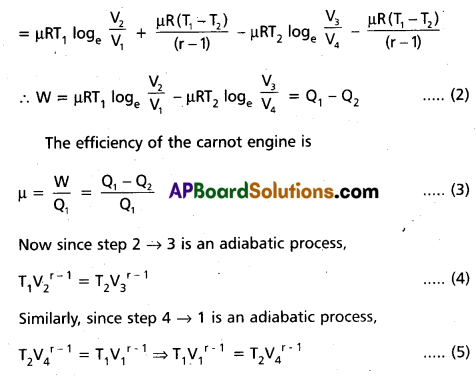Thoroughly analyzing TS Inter 1st Year Physics Model Papers and TS Inter 1st Year Physics Question Paper May 2017 helps students identify their strengths and weaknesses.
TS Inter 1st Year Physics Question Paper May 2017
Time: 3 Hours
Maximum Marks: 60
Section – A (10 × 2 = 20)
Note :
- Answer all questions.
- Each question carries two marks.
- All are Very Short Answer Type Questions.
Question 1.
What is the contribution of S. Chandra Sekhar to Physics ?
Answer:
While studying the contitution of the stars, he has proved that the maximum mass that a white dwarf can have is 1.4 times the solar mass. This mass is known as Chandrasekhar limit. If a star crosses this limit, it has to face a catostropic collapse.
Question 2.
Distinguish between accuracy and precision.
Answer:
| Accuracy | Precision |
| 1. The accuracy of a measurement of any physical quantity made by any measuring instrument is a measure of how close the measured value is to the true value of the quantity. | 1. The precision of the measuring instrument denotes up to what limit (or) resolution the quantity can be measured with the given instrument. |
| 2. The accuracy depends on errors. | 2. The precision does not depend on errors. |
![]()
Question 3.
\(\vec{A}\) = \(\vec{i}\) + \(\vec{j}\). What is the angle between a Vector and the X-axis ?
Answer:
\(\vec{A}\) = \(\vec{i}\) + \(\vec{j}\)
cos α = \(\frac{A x}{|A|}\) = \(\frac{1}{\sqrt{1^2+1^2}}\) = \(\frac{1}{\sqrt{2}}\) ; (∵ Ax = 1)
α cos-1 [latex]\frac{1}{\sqrt{2}}[/latex] = 45°
Question 4.
Why does a heavy rifle not recoil as strongly as a light rifle using the same cartridges and velocity ?
Answer:
Recoil of the Gun V = \(\frac{\mathrm{mu}}{\mathrm{M}}\)
Due to heavy mass of rifle the recoil is less.
Question 5.
Define coefficient of viscosity. What are its units ?
Answer:
The property of a medium which opposes the relative motion between two successive layers is called viscosity.
C.G.S. unit for co-efficient of viscosity is poise.
Question 6.
Why are liquid drops and soap bubbles spherical ?
Answer:
The surface tension of a liquid tends to have minimum surface area. For a given volume, the surface area is minimum for a sphere. Hence rain drops are spherical shape.
Question 7.
What is regelation ? Write one of its application.
Answer:
The phenomenon of refreezing is called regelation.
Applicaion : skating is possible on ice.
Question 8.
Write the equation for mean free path.
Answer:
Mean free path \(\vec{I}=\frac{1}{\sqrt{2 n \pi d^2}}\)
Where n is the number density and d the diameter of the molecule.
Question 9.
State Boyle’s law and Charles’ law.
Answer:
Boyle’s law : At constant temperature, the pressure of a given mass of gas varies inversely with volume.
P ∝ \(\frac{1}{\mathrm{~V}}\) ⇒ PV = Constant.
Charle’s law : At constant pressure, the volume of the gas is proportional to its absolute temperature.V ∝ T.
![]()
Quetsion 10.
Define Latent Heat. Write its units.
Answer:
The quantity of heat absorbed or liberated during the change of state by unit mass of substance, without any change in temperature is called latent heat i.e., L = Q / m units of L are, J/kg, cal/gm.
Section – B (6 × 4 = 24)
Note :
- Answer any six questions.
- Each question carries four marks.
- All are Short Answer Type Questions.
Question 11.
By using parallelogram law of vectors. Derive an expression for the magnitude and direction of the resultant vector.
Answer:
“If two vectors acting at a point be represented in magnitude and direction by the two adjacent sides of a parallelogram, then their resultant is represented in magnitude and direction by the diagonal of the parallelogram passing through the same point”.
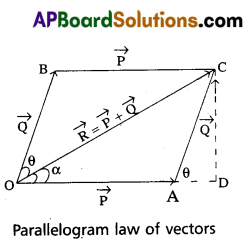
Explanation : \(\overrightarrow{\mathrm{P}}\) and \(\overrightarrow{\mathrm{Q}}\) are two vectors acting at a point ‘O’ with an angle ‘θ’ between them. \(\overrightarrow{\mathrm{OA}}\) and \(\overrightarrow{\mathrm{OB}}\) represent \(\overrightarrow{\mathrm{P}}\) and \(\overrightarrow{\mathrm{Q}}\) in magnitude and direction. Parallelogram OACB is completed. The diagonal OC represents the resultant of \(\overrightarrow{\mathrm{P}}\) and \(\overrightarrow{\mathrm{Q}}\) in magnitude and direction.
Magnitude of the resultant: OA is produced and perpendicular CD is drawn to it in the triangle ODC.
OC2 = OD2 + CD2
= (OA + AD)2 + CD2
= OA2 + AD2 + 2 OA. AD + CD2
But in triangle CAD
AD2 + CD2 = AC2
cos θ = \(\frac{A D}{A C}\)
⇒ AD = AC cos θ
OC2 = OA2 + AC2 + 2 OA. AD
R2 = p2 + Q2 + 2PQ cos θ
R = \(\sqrt{P^2+Q^2+2 P Q \cos \theta}\)
Resultant direction :
From Δle COD
Tan α = \(\frac{C D}{O D}\) = \(\frac{C D}{O A+A D}\)
From AD = AC cos θ = Q cos θ
and CD = Q sin θ
∴ Tan α = \(\frac{Q \sin \theta}{P+Q \cos \theta}\)
Question 12.
Mention the methods used to decrease the friction.
Answer:
- Polishing : By polishing the surfaces of contact, friction can be reduced.
Bearings : The rolling friction is less than the sliding friction, hence free wheels of a cycle, motor car, - dynamos etc., are provided with ball bearings to reduce friction. Bearing convert sliding motion into rolling motion.
- Lubricants: The lubricant forms a thin layer between surfaces of contact. It reduces the friction. In light vehicles or machines, oils like “three in one” are used as lubricants. In heavy machines greasure is used. In addition to this they guard the mechanical parts from over heating.
- Streamlining : Automobiles and aeroplanes are streamlined to reduce the friction due to air.
Question 13.
Distinguish between centre of mass and centre of gravity.
Answer:
| Centre of mass | Centre of Gravity |
| 1. Point at which entire mass of the body is supposed to be concentrated, and the motion of the point represents motion of the body. | 1. Fixed point through which the weight of the body act. |
| 2. It refers mass of a body. | 2. It refers to the weight acting on all particles of the body. |
| 3. In a uniform gravitational field centre of mass and centre of gravity coincide. | 3. In a non-uniform gravitational field, centre of gravity and centre of mass do not coincide. |
| 4. Centre of mass of the body is defined to describe the nature of motion of a body as a whole. | 4. Centre of gravity of body is defined to know the amount of stability of the body when supported. |
![]()
Question 14.
Define angular acceleration and torque. Establish the relation between angular acceleration and torque.
Answer:
Angular acceleration (α) : The rate of change of angular velocity is called angular acceleration.
α = \(\frac{\omega}{t}\) (or) \(\frac{t \omega}{d t}\)
Torque (τ) : Torque is defined as the product of force and perpendicular distance of the line of action of the force from the point.
\(\vec{\tau}\) = \(\vec{r}\) × \(\vec{F}\) = rF sin θ
Relation between angular acceleration of torque :
Torque (τ) = Perpencicular distance × Force
\(\vec{\tau}\) = \(\vec{r}\) × \(\vec{F}\)
τ = r × ma (∵ F = ma)
τ = ma (rα) (∵ a = rα)
τ = mr2 α
τ = Iα
Question 15.
State Kepler’s law of planetary motion.
Answer:
The three laws of Kepler can be stated as follows.
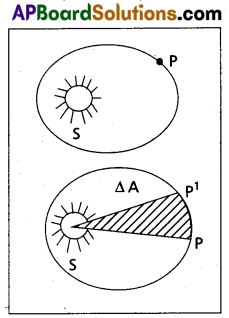
The three laws of Kepler can be stated as follows.
- Law of orbits : All planets move in elliptical orbits with the sun situated at one of the foci.
- Law of areas : The line that joins any planet to the sun sweeps equal areas in equal intervals of time.
- Law of periods : The square of the time period of revolution of a planet is proportional to the cube of the semi-major axis of the ellipse traced out by the planet. T2 α R3.
Question 16.
Describe the behaviour of a wire under gradually increasing load.
Answer:
Behaviour of a wire under the action of gradually increasing load :
When the load is increased in steps, a graph is drawn between stress in Y – axis and corresponding strain on X-axis. Then the curve obtained is as shown in the figure. When a wire be clamped at one end and loaded at the other end, it undergoes four following steps.
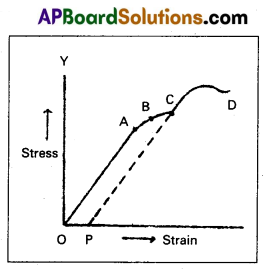
1) Proportional limit : In the linear position OA, stress is proportional to strain i.e., Hooke’s law is obeyed by the wire upto the point ‘A’, the graph is a straight line. Whenever the stretching force at ‘A’ is removed the wire regains its original length. ‘A’ is called proportional limit.
2) Elastic limit : In the graph ‘B’ is the elastic limit. Though the , wire doesn’t obey Hooke’s law at ‘B’, the wire regains its original length after removing the stretching force at ‘B’. Up to point ‘B’ the wire is under elastic behaviour.
3) Permanent set (or) yield point : In the graph ‘C’ is the yield point. If the stretching force at ‘C, is removed the wire doesn’t regain its original length and the length of the wire changes permanently. In this position the wire flows like a viscous liquid. After the point ‘C’, the wire is under plastic behaviour. ‘C’ is called permanent set or yield point.
4) Breaking point : When the stress increases the wire becomes thinner and thinner. When the stress increases to a certain limit the wire breaks. The stress at which the wire breaks is called Breaking stress and the point ‘D’ is called Breaking point.
5) Elastic fatigue : The state of temporary loss of elastic nature of a body due to continuous strain is called elastic fatigue. When a body is subjected to continuous strain within the elastic limit it appears to have lost elastic property temporarily to some extent and becomes weak.
Question 17.
State and explain Newton’s law of cooling.
Answer:
Statement : The rate of cooling of a body is directly proportional to the difference in the temperature of the body and its surrounding.
Explanation : If TB and TS are the temperatures of the body and the surroundings and let dQ be the quantity of heat lost by the body during the time dt.
Rate of cooling a \(\frac{\mathrm{dQ}}{\mathrm{dt}}\)α(TB – TS)
According to stefan’s law, The rate of cooling due to radiation is directly proportional to (TB4 – TS4)
If the difference between TB and TS is small leading to
TB + TS = 2TS, then \(\frac{\mathrm{dQ}}{\mathrm{dt}}\) = (TB2 + TS2) (TB + TS) (TB – TS)
= 4TS3 (TB – TS);\(\frac{\mathrm{dQ}}{\mathrm{dt}}\)α (TB – TS)
When the object is placed in the surroundings of low temperatures, the rate of,cooling due to convection is known as “Newton’s law of cooling”.
Newton’s law of cooling is applicable :
- Loss of heat is negligible by conduction and only when it is due to convection.
- Loss of heat occurs in a stream lined flow of air i.e., forced convection.
- Temperature of the body is uniformly distributed over it.
- Temperature differences are moderate i.e., upto 30 K, however if heat body is due to forced convection the law is valid for large differece of temperature also.
![]()
Question 18.
A ball.is thrown vertically upwards with a velocity of 20 ms-1 from the top of a multistorey building. The height of the point from where the ball is thrown is 25.0 m from the ground. How high will the ball rise from the ground ? [g = 10ms-2]
Answer:
Given, u = 20m/s; g = 10ms-2; H = 25 m
maximum height, hm = \(\frac{\mathrm{u}^2}{2 \mathrm{~g}}\) = \(\frac{(20)^2}{2 \times 10}\) = 20m
Height reached by ball from the
ground = H + hmax = 25 + 20 = 45m.
Section – C (2 × 8 = 16)
Note :
- Answer any two questions.
- Each question carries eight marks.
- All are Long Answer Type Questions.
Question 19.
State and prove the law of conservation of energy in case of a freely falling body. An elevator can carry a maximum load of 1800 kg. (elevator + passengers) is moving up with a constant speed of 2 ms-1. The frictional force opposing the motion is 4000 N. Determine the minimum power delivered by the motor to the elevator in watts.
Answer:
Statement: Energy can neither be created not destroyed, but it can be converted from one form toanother form. The total energy of a system always remains constant.
Verification in the case of freely falling body : Let a body of mass’m’ be at a height ‘h‘ above the ground. When it is freely falling with an acceleration due to gravity ‘g’, the potential energy gradually decreases and at the same time the K.E. of the body increases.
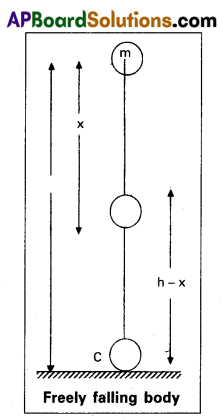
When the body is at A :
At the highest point final velocity v = 0
Kinetic energy K.E. = \(\frac{1}{2}\) mv2 = 0
Potential energy P.E. = mgh
Total energy at A = E = P.E. + K.E. = mgh + 0
∴ Total energy at A, E = mgh …………. (1)
When the body is at B :
As the body falls freely, after travelling a distance x, reaches the point B.
At ‘B’ the body possesses both P.E. and K.E.
Potential energy P.E. = mg (h – x)
P.E = mgh – mgx
Kinetic energy K.E. = \(\frac{1}{2} m v_1^2\)
Total energy at B = P.E + K.E.
= mgh – mgx + \(\frac{1}{2} m v_1^2\)
For freely falling body
s = x
u = 0
v = v1
a = g
Substitute these values in eqn.
v2 – u2 = 2as
\(v_1^2\) – 02 = 2gx.
\(v_1^2\) = 2gx
Total energy at
B = mgh – mgx + \(\frac{1}{2}\) m.2gx
= mgh – mgx + mgx = mgh
∴ Total energy at B, E = mgh …………… (2)
When the body is at C :
The body falls through a distance of ‘h’ and touches the ground at C with a velocity v2.
Potential energy at C = mg = 0
Kinetic energy K.E. = \(\frac{1}{2} m v_2^2\)
Total energy at C = 0 + \(\frac{1}{2} m v_2^2\) = \(\frac{1}{2} m v_2^2\)
For freely falling body s = h, u = 0, v = v2 a = g
Substitute these values in eqn. v2 – u2 = 2as ; \(v_2^2\) – 02 = 2gh
\(v_2^2\) = 2gh
Substitute this value in total energy, we get
Total energy at C = \(\frac{1}{2} m v_2^2\) = \(\frac{1}{2}\) m 2gh
∴ Total energy at C = mgh
In the above three cases total energy of the body is proved constant. Hence law of conservation of energy is proved.
![]()
Question 20.
Show that the motion of a simple pendulum is simple harmonic and hence derive an equation for its time period. What is a seconds pendulum ?
Answer:
- Consider simple pendulum, a small bob of mass m tied to an inextensible mass less string of length L and other end of the string is fixed from a rigid support.
- Once the bob is slightly displaced and released, it begins to oscillate about mean position.
- Let θ be the angular displacement and T be the tension in the string.
- The forces acting on the bob are
(a) tension T along the string
(b) weight mg acts ertically downwards. - The force mg can be resolved into two components.
- mg cos θ along the PA and
- mg sin θ acts along PB.
- From figure at point P,
T = mg cos θ ………… (1) - The force mg sin 0 will provide the restoring torque, which tends to bring the bob back to its mean position O.
- The restoring torque is given by
τ = Restoring force × ⊥lar distance
τ = – mg sin θ × L …………. (2)
Here negative sign shows that the torque acts to reduce θ. Then sin θ is replaced by
θ i.e., sin θ = θ.
τ = – mg L θ ………….. (3)
(Qsin θ = θ . \(\frac{\theta^3}{3 !}\) + \(\frac{\theta^5}{5 !}\) …… ) - From equation (3), we note that τ ∝ θ and this τ will bring the bob back towards its equilibrium position.
So, if the bob is left free, it will execute angular simple harmonic motion.
Comparing equation (3), with the equation τ = – kθ, we have spring factor,
k = mgl. - Here inertia factor = Moment of inertia of the bob about the point of suspension = mL2
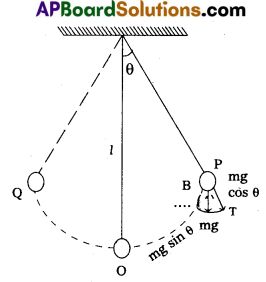
- In S.H.M, Time period (T) = 2π \(\sqrt{\frac{\text { Inertia factor }}{\text { Spring factor }}}\)
T = 2π \(\sqrt{\frac{\mathrm{mL}^2}{\mathrm{mgL}}}\)
T = 2π \(\sqrt{\frac{L}{g}}\)
Seconds pendulum : A pendulum whose time period is 2 seconds is called seconds pendulum.
T = 2 seconds.
![]()
Question 21.
Explain reversible and irreversible processes. Describe the working of a Carnot engine. Obtain an expression for the efficiency.
Answer:
Reversible process : A process that can be retraced back in the opposite direction in such away that the system passes through the same states as in the direct process, and finally the system and the surroundings return in their original states, is called a reversible process.
A reversible process is only a purely idealised process.
Examples :
- Slow isothermal and slow adiabatic changes.
- Peltier effect and seeback effect.
- Fusion of ice and vaporisation of water.
Irreversible process : “A process that cannot be retraced back in the oposite direction” is called as irreversible process.
In this process the system does not pass through the same intermediate states as in the reversible process.
All natural processes such as conduction, radiation, radioactivity etc., are irreversible.
Example :
- Work done against friction.
- Heat produced in conductors by passing a current through it. (Joule heating)
- Diffusion of gases.
Carnot Engine : A reversible heat engine operating between two temperatures is called a carnot engine. The cycle operating it is known as carnot’s cycle. In this cycle the working substance (say an ideal gas) is taken through a cycle by means of two isothermals and two adiabatics. The four operations are shown in P – V (indicator) diagram.
Step 1 → 2 : Isothermal expansion of the gas taking its state from (P1, V1 T1,) to (P2, V2, T). It is shown in curve (a)
The heat absorbed by the gas (Q1) from the reservoir at temperature T1 equals the workdone by the gas. i.e.
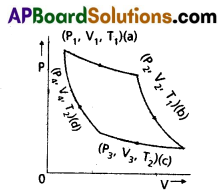
W1 → 2 = Q1 = µRT1loge(\(\frac{V_2}{V_1}\))
Step 2 → 3 : Adiabatic expansion of the gas from (P2, V2, T1,) to (P3, V3, T2). It is shown in curve (b). The work done by the gas is given by
W2 → 3 = \(\frac{\mu R\left(T_1-T_2\right)}{(r-1)}\)
Step 3 → 4 : Isothermal compression of the gas from (P3, V3, T2) to (P4 , V4, T2). It is shown in curve (c). Heat released (Q2) by the gas to the reservoir at temperature T2 equals the work done on the goes.
i.e., W3 → 4 = µRT2loge(\(\frac{V_4}{V_3}\)) = µRT2loge(\(\frac{V_3}{V_4}\)
Step 4 → 1 : Adiabatic compression of the gas from (P4 , V4, T2) to (P1, V1, T1). It is shown in curve (d) Work done on the gas is given by.
W3 → 4 = µR\(\frac{\left(T_2-T_1\right)}{(r-1)}\) = – µR\(\frac{\left(T_1-T_2\right)}{(r-1)}\)
Total workdone by the gas in one complete cycle is
W = W1 → 2 + W2 → 3 + W3 → 4 + W4 → 1
